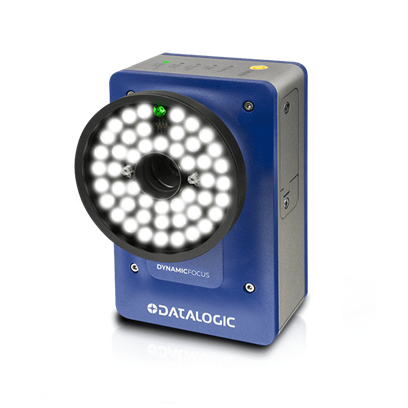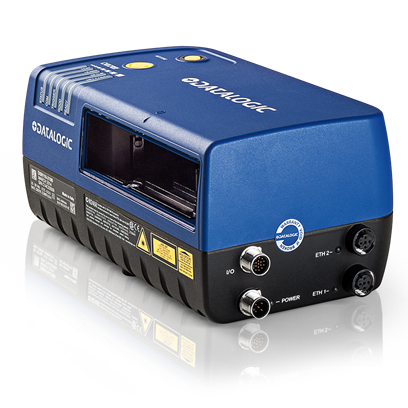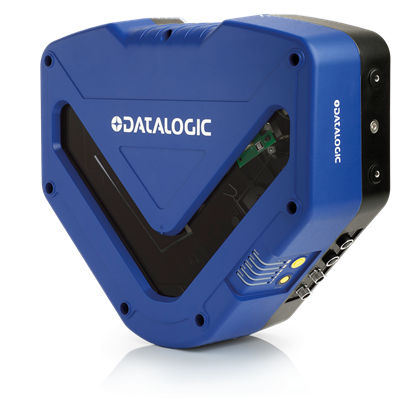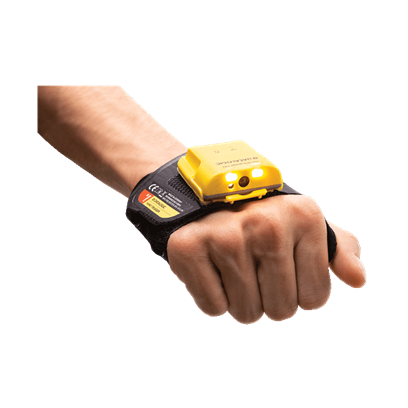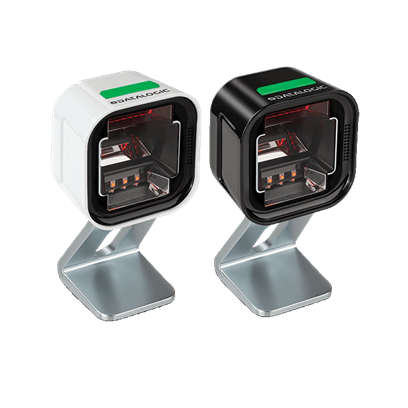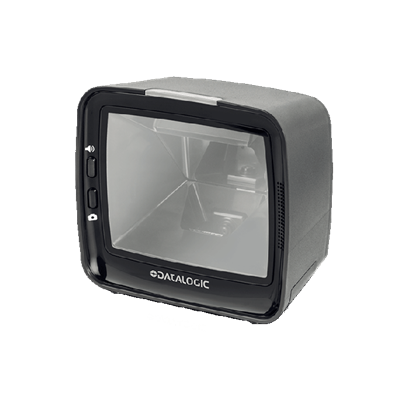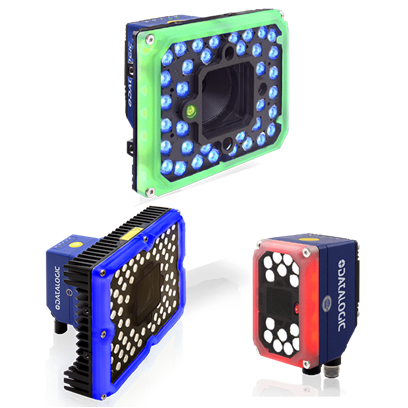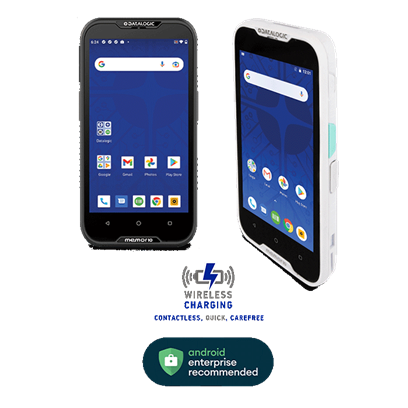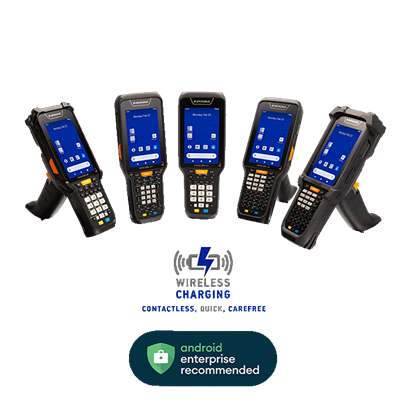
Order Picking Systems
Order Picking Systems
WHY ARE WAREHOUSE ORDER PICKING SYSTEMS IMPORTANT?
The heart to any successful order fulfillment and warehouse management processes is to properly employ the correct order picking system. It stands to reason that there is a direct correlation between the measurable success of a business and consistent, successful fulfillment processes. The action of picking items needs to be fast, efficient, and accurate when fulfilling customer orders to ensure customer satisfaction. Having strong warehouse order picking systems in place represents a major element of an overall successful implementation in supply chains.
Over recent years there has been exponential growth in e-commerce and online shopping. It is understandable then why the correct order picking system is an imperative consideration by many for fruitful order fulfillment. Warehouse managers realize the success or failure of their order fulfillments will depend on the picking method they employ.
HOW TO DETERMINE THE BEST ORDER PICKING SYSTEM?
Not all warehouses and fulfillment centers are the same as each other, so it stands to reason not all order picking systems are interchangeable. To optimize the fulfillment processes, and in doing so ensure customer satisfaction, a few key factors need to be analyzed in the selection of the correct system. The following considerations must be answered and analyzed to assure the correct choice of a picking system is made for the optimization of their fulfillment processes and maintaining control of warehouse operation costs:
- Size of warehouse and inventory layout
- Types and number of orders
- Size of fulfillment staff
- Need to streamline picking time
- Types of order picking
- Save time to quickly fulfill orders and ship out orders
WHAT ARE THE COMMON CURRENT ORDER PICKING SYSTEMS IN USE TODAY?
- Single order picking
- Also known as “discrete picking”
- Operator fills one order at a time walking the warehouse floor to pull stock keeping unit or SKUs for each item in the order
- This method works best for smaller warehouses where the orders usually have a small amount of items
- Cluster Picking
- Can also be known as “batch picking”
- Good choice when multiple orders have the same SKUs
- Operator picks similar products for multiple orders from same area of warehouse at one time, resulting in consolidation of operator’s time
- Decreases the need for an operator to repeatedly go back to the same areas to pull the same SKUs for different orders
- Benefit of cluster picking is that the pickers can pull multiple orders at the same time
- Picked and passed
- Also known as “zone picking”
- Pickers assigned to a specific zone in the warehouse
- Pickers pull items from order that are specific to their zone, then “pass” the order to the next picking zone
- Warehouse needs to be laid out correctly for a zone concept keeping in mind which orders move faster than others, correct inventory management of each zone, etc.
- Wave picking
- Useful for large orders in larger warehouses
- Orders are grouped by a warehouse management system (WMS) by criteria such as: customer location, delivery date, similar SKUs, products, and zones
- Operators pick orders by assignment of different waves throughout the day
- Voice picking
- Pickers wear headsets on the warehouse floor
- Instructions on items to be pulled and the item’s real time location are transmitted via the headset
- Picking managed by an order management system (OMS) to increase the picker’s speed and accuracy via commands delivered to the headset
- Picker verbally confirms when order completed
- Pick and pack
- Operators fill single orders one at a time
- Pull SKUs from pick list for one order and place in carton in which it will be shipped
- Once all items are verified and order fulfilled pickers finish preparation of carton for the shipping and delivery of the order
AUTOMATED PICKING
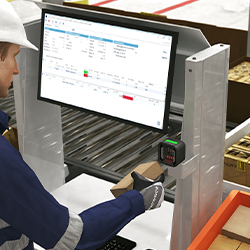 When using Goods To Persons (GTP) strategy, the operators work in dedicated areas and the goods reach the areas by means of automated material handling solutions (Mini-loads, AGVs or AMRs). The items are identified and placed in the final or temporary package.
When using Goods To Persons (GTP) strategy, the operators work in dedicated areas and the goods reach the areas by means of automated material handling solutions (Mini-loads, AGVs or AMRs). The items are identified and placed in the final or temporary package.
Warehouse picking is the process where individual items are picked from a fulfilment facility in order to satisfy customer demands. Traditional methods for such GTP (Goods To Persons) operations were very labor intensive, and in some cases made up more than 50% of a distribution center’s operating costs. Modern warehouses have a higher degree of automation, allowing for delivery of goods to individual operator stations by means of fully integrated material handling systems such as conveyors, automated guided vehicles, or autonomous mobile robots.
Customer satisfaction is one of the highest priorities in any warehouse operation and picking therefore directly impacts business reputation and profitability. Picking strategies are important and optimizing them are a way of reducing costs significantly and increasing both efficiency and accuracy. Using the right technology is paramount, enabling the operators to view picking lists wirelessly, access systems in real time and utilize software for guidance that all tasks have been executed correctly. When working in dedicated areas where all goods are delivered through automated means the operator needs to rely on a high performing fixed position presentation scanner.
The Magellan 1500i is perfectly suited to such applications as it small enough to be mounted anywhere yet covers a large reading area. The operator should not have to worry about different types of barcode, poor illumination, or the ability of the scanner to read from damaged or poorly printed labels. What is important is that a top performing scanner is used so that operators can comfortably work throughout the longest of shifts.
HANDS-FREE
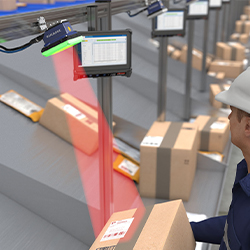 Hands free is often used in order fulfilment, as it is flexible and easy to be implemented. A portion of the sorter is dedicated to e-commerce and the operator prepares the order in a fast and productive way, as physical handling of the item is not needed when scanning the barcode.
Hands free is often used in order fulfilment, as it is flexible and easy to be implemented. A portion of the sorter is dedicated to e-commerce and the operator prepares the order in a fast and productive way, as physical handling of the item is not needed when scanning the barcode.
The sheer volume of consumer goods being delivered directly to our doors has seen a significant rise over the last 18 months, mainly due to the need for ordering online versus buying from traditional brick and mortar stores. Its not a bad thing though as we have forced companies into streamlining their operations to fulfil demands where consumers make a few mouse clicks and expect delivery the very next day. What goes on behind the scenes however is down to massive uptake of automated material handling solutions in warehouses and distribution centers. The idea is to make the warehouse operators life as easy as possible, thereby increasing efficiency and saving time.
Datalogic has created hands free scanning kits containing products such as the Matrix 320 or Magellan 3450. In both cases, the end goal is the same: using a fixed position barcode scanner to read barcodes on items on the fly, without having to use handheld readers. The results are twofold. Firstly, the operators are more productive and can focus on the fulfilment process without the need to have to pick up a device, aim it at the barcode, scan the barcode, and return the device to its holder. Secondly, there is no need to clean or disinfect the fixed reader as it is never touched by human hands. Scanning time is therefore reduced by 50% (workers can handle 40-80 additional parcels per hour); there are shorter delays between shift changes. Installing and using a hands-free scanning kit from Datalogic is an easy choice, with a very quick ROI due to the massive increase in productivity.
POCKET SORTER
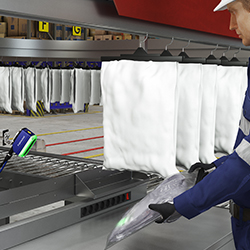 Pocket sorters are often used as a flexible temporary buffer to manage seasonal peaks and e-commerce returns. They are the ideal link between the different areas of the DC. The Matrix 320 in Hands-Free mode is the perfect answer to pocket sorter loading and peaking requirements.
Pocket sorters are often used as a flexible temporary buffer to manage seasonal peaks and e-commerce returns. They are the ideal link between the different areas of the DC. The Matrix 320 in Hands-Free mode is the perfect answer to pocket sorter loading and peaking requirements.
Modern distribution centres face a variety of demands. The rise in ecommerce fulfilment due to massive increases in online ordering requires distribution centers to up their game when it comes to automation. Order volumes are growing while, at the same time, lot sizes are shrinking. The modern DC must be able to optimally process a constantly changing range of goods. Omni-channel fulfilment is now the daily business in many areas, coming hand-in-hand with increasing demands for flexibility, quality and customer service. Product returns are also a lot higher, especially considering the number of products that are purchased without the recipient physically seeing them first.
A Pocket Sorter, also known as a Pouch Sorter, is an overhead sortation system which relies on pockets, pouches, or bags to store and convey products. A trolley or rail system is installed on the ceiling of the warehouse/distribution center, allowing the facility to reclaim otherwise unused space. Individual pockets or pouches hang from this rail system, and Pockets are conveyed individually and can be moved independently. Items are picked into pouches (typically one unit per pouch), and the pouch is then transported for temporary storage, further picking, processing, and packing. Throughput for pouch/pocket sorters typically falls somewhere in the range of 100-120 pouches per minute. Pocket sorters are particularly common in ecommerce order fulfilment and facilitate batch picking strategies.
Distribution centers rely on pocket sorters to ease chaos and provide both a buffer zone for products and a link between different areas within the facility. This efficiency is realized best when relying on a hands-free scanning solution such as one utilizing the Matrix 320. Operators save time by not having to individually scan items using hand scanners, and instead rely on the Matrix 320 large filed of view and depth of filed to scan items quickly and efficiently.
PICK TO LIGHT
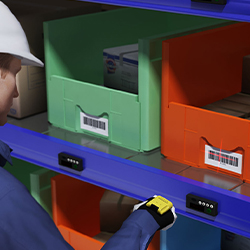 Pick-To-Light (PTL) is another typical picking process: the operator manually picks the items by following a light indication. The picking is confirmed by either pushing a button or scanning the location barcode with a Datalogic wearable device.
Pick-To-Light (PTL) is another typical picking process: the operator manually picks the items by following a light indication. The picking is confirmed by either pushing a button or scanning the location barcode with a Datalogic wearable device.
A Pick to light (or PTL) system is an order picking technology used by warehouses and distribution centers. It utilizes lights and LEDs on racks or shelves to indicate pick locations and provide easy visual guidance to order pickers throughout the picking process. PTL systems increase picking efficiency compared to traditional picking with paper pick lists. Although PTL can been used for picking cases, it is used today mainly for picking large quantities of individual items in high density/high velocity pick locations.
PTL systems are fully integrated with warehouse management systems and are their purpose is to bring velocity to picking operations, whilst providing real time feedback on stock levels. PTL follow some simple basic steps. Operators scan a barcode that is on a tote or carton, and this triggers the PTL system to light up the required pick locations for the order. The operator has clear guidance on where to go and collect the items and correct quantity, avoiding any unnecessary travel or time.
The operator will pick the item or items and confirm the pick by either pushing a button or scanning the location barcode. Traditional methods rely on the use of wireless handheld scanners that require taking the unit out of a belt holster with one-handed operation, making it more difficult to carry large or multiple items.
Datalogic are makers of the Handscanner, the smallest and lightest wearable scanner on the market. Mounted on the back of an operator’s hand and enabled with a simple thumb press, the user is able to keep both hands free at all times. When combined with Datalogic mobile computers such as the Skorpio X5 or Memor 10 provides the user with an ultrafast and efficient picking solution that has full data collection capability. It is estimated that 4 seconds are saved per scan by using a Handscanner, and when multiplied by the number of scans required per month, gives an amazing return on investment in a short period.
MANUAL PICKING
 Picking is the first step of the order fulfilment process; the picker’s mission is to complete the picking list in the shortest time, without any mistakes. By following the WMS instructions on its display the operator is able to optimize the picking sequence using the Skorpio X5.
Picking is the first step of the order fulfilment process; the picker’s mission is to complete the picking list in the shortest time, without any mistakes. By following the WMS instructions on its display the operator is able to optimize the picking sequence using the Skorpio X5.
Picking is one of the main functions of warehouse logistics, and the range of options vary greatly between manual and fully automated picking systems. The key point here though is to streamline the process regardless of which picking regime you operate in. The ultimate goal is to increase efficiency of processes and people and being able to move as much product as possible in and out of a distribution centre. The more demand you can fulfil, the greater revenue you generate. The picker has one objective – to complete the picking list in the shortest time possible. This is based on the Person To Goods (PTG) principle, where the picker accesses goods stored in fixed locations. Regardless of which methodology is used (Pick To Light, Pick By Voice) human beings remain an essential factor when it comes to carrying out picking activities due to their perception and decision making capabilities. It is therefore essential that they are equipped with the best tools for the job.
The Skorpio X5 from Datalogic is one of the best rugged PDT (Portable Data Terminal) that money can buy. It is suitable for both indoor and outdoor use and helps staff to remain productive even during long and demanding work shifts. Fully integrated with the Warehouse Management System and equipped with a large scan engine with an extra long range, makes the Skorpio X5 a reliable companion for operators, scanning any barcode in any condition. Operators can work quickly by following WMS instructions on the Skorpio X5 display and help to optimize any challenging picking sequences.
AUTOMATED SORTING
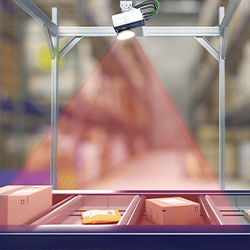 An automated sorting process is the best way to manage large volumes of items; the core of this process is the Datalogic AV900, which identifies parcels on sorters running at up to 2.5 meters per second! The AV900 enormously increases plant productivity.
An automated sorting process is the best way to manage large volumes of items; the core of this process is the Datalogic AV900, which identifies parcels on sorters running at up to 2.5 meters per second! The AV900 enormously increases plant productivity.
High-Speed sortation systems are now a standard requirement for any warehouse or distribution center that has a large-volume inventory. They enable quick sorting of products of all shapes and sizes, and route them to their correct destinations until they’re ready to be shipped. There are several different types of high-speed sortation systems, and it’s important that these systems are able to process hundreds of items per minute.
The type of high-speed sortation system in a warehouse depends on its size, inventory needs, and number of operators. A typical high-speed sorter will move hundreds of items per minute, equating to tens of thousands of items per hour. The four main types of high-speed sortation systems include tilt-tray, cross-belt and slide-shoe sorters. The key to keeping a sorter moving at such high speeds is utilizing an industrial imager capable of reading barcodes for product identification and capturing images for quality control purposes.
The AV900 from Datalogic meets these specifications with ease and is capable of working with sorters running at speeds of up to 2.5 meters per second. The key to achieving this incredible spec is a high-resolution wide area sensor. Any closely positioned, or misaligned items will still be identified even with barcodes that are damaged or hard to read. Plant productivity will not be compromised with such a powerful and heavyweight performer that is the AV900.
HOW CAN DATALOGIC HELP OPTIMIZE THE ORDER FULFILLMENT AND PICKING PROCESSES?
Since order fulfillment processes can comprise around 50% of warehouse operational costs, it is important to determine not only the right OMS and WMS but also the correct technologies that complement the endeavor. Whatever the style of warehouse order picking system best fits, one of the next considerations would be to determine the best way to efficiently an accurately scan the barcode tied to the SKU of the pulled product. Datalogic, a global leader of automatic data capture solutions, has a large technological portfolio that offers multiple solutions to ensure customers’ orders are accurately picked and packed and in so doing gain customer satisfaction. Below are some technological solutions representative of possible picking options.
- Magellan 1500i – With Datalogic’s latest digital imaging technology, it seamlessly decodes both 1D and 2D bar codes of SKUs. With the most compact footprint in its class, the Magellan 1500i is an ideal choice for space constrained applications. Additionally, intelligent host cable routing ensures that the scanner is both comfortable in the hand and can back right up to a wall or display for maximum space efficiency.
- HandScanner – The lightest and smallest wireless wearable 2D scanner. The HandScanner instantly captures 1D/2D barcodes through a megapixel sensor and is available in two models: Standard Range – designed for close range scanning between 10 to 80 cm / 3.9 to 31.5 – or MidRange – from 30 to 150 cm / 11.8 to 59 in which covers a wide variety of uses in warehouses, plant floors, docks, and stock yards. The HandScanner can be paired with Datalogic’s mobile computers to provide workers with a full data collection solution suitable for any application.
- Matrix 320 – A versatile stationary industrial scanner (SIS) that can be utilized whether mounted on a conveyor system, or at a hands-free station offers rapid and accurate reading of SKUs. Its efficiency is realized best when relying on a hands-free scanning solution operators save time by not having to individually scan items and instead rely on the Matrix 320 large field of view and depth of field to scan items quickly and efficiently.
- Skorpio X5 – This is one of the best rugged Portable Data Terminal (PDT) that money can buy. It is suitable for both indoor and outdoor use and helps staff to remain productive even during long demanding work shifts. Fully integrated with the Warehouse Management System and equipped with a large scan engine with an extra-lone range, makes the Skorpio X5 a reliable companion for operators, scanning any barcode in any condition. Operators can work quickly by following WMS instructions on the Skorpio X5 display and help any challenging picking sequences.



